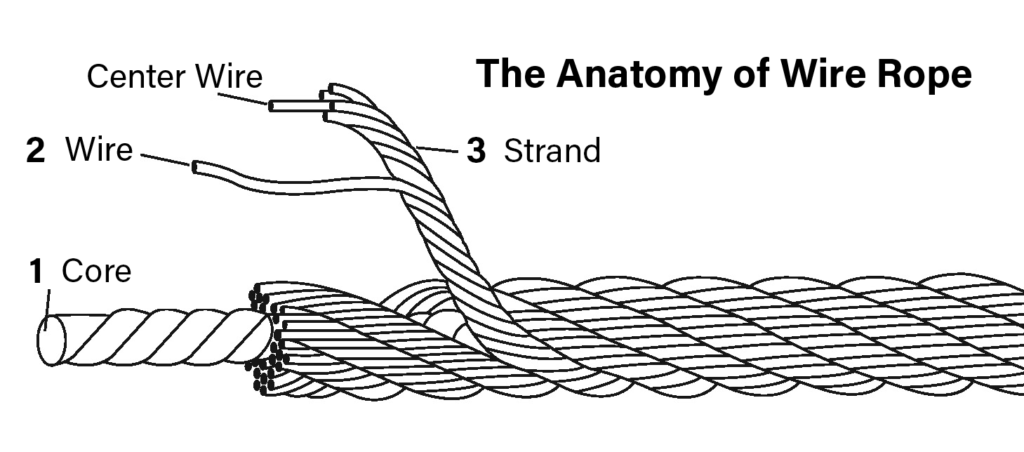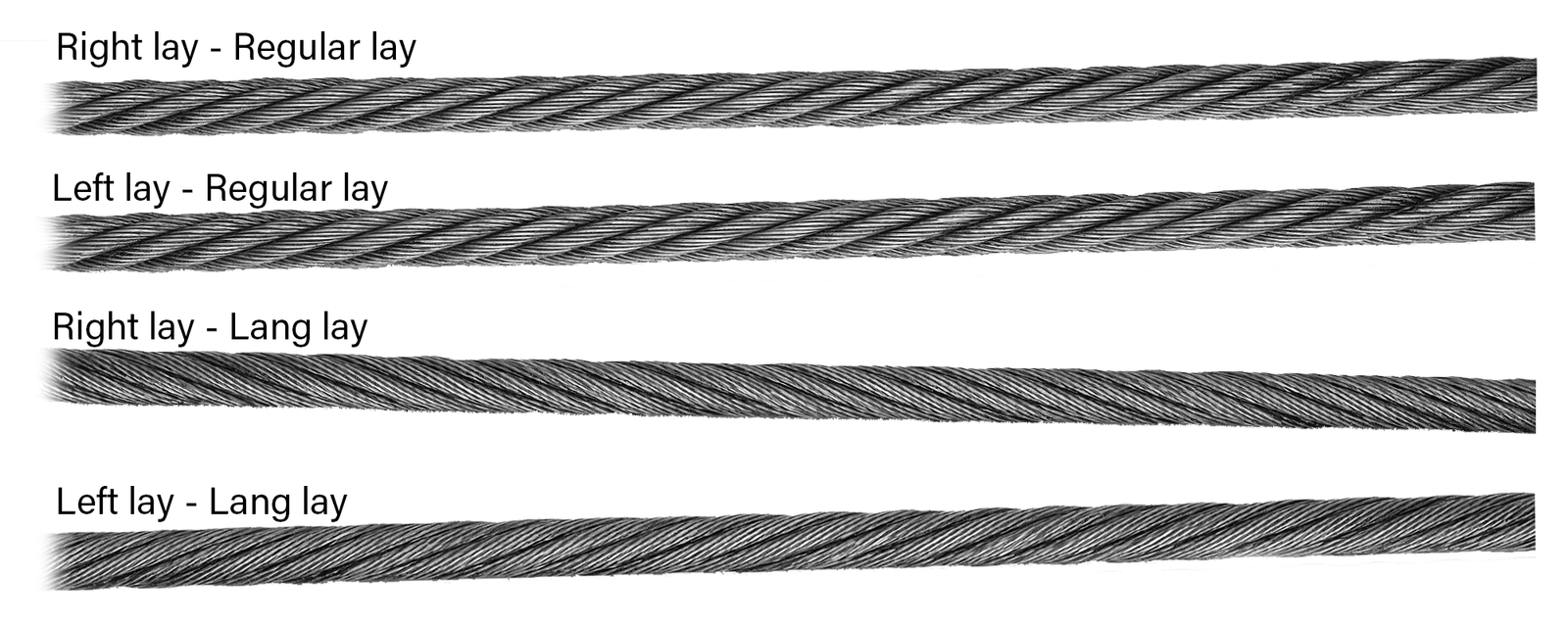Wire Rope Fundamentals
Wire rope serves as a versatile alternative to chains and finds application across a diverse range of uses, including overhead lifting, rigging, lashing, towing, and construction tasks. Its presence can be noted in various structures such as elevators, bridges, cranes, aircraft, and anywhere a robust and reliable means of transmitting mechanical force is essential.
Wire rope, a complex mechanical assembly with numerous interconnected elements, frequently integrates with wire rope hardware and various lifting and rigging apparatuses.
While not an exhaustive guide, this article offers an introductory glimpse into the fundamental components of wire rope.
The Structure of Wire Rope
Wire rope comprises three integral elements:
1.The Core: Positioned at the center of the wire rope, the core functions as the foundational support structure that holds the entire rope together. There exist three primary core types:
Fiber Core: Comprising either synthetic or sisal materials, the fiber core represents the weakest core option.
Strand Core: In this configuration, the core itself takes the form of a wire strand, akin to the other strands within the rope.
Independent Wire Rope Core (IWRC): The IWRC stands as a separate wire rope core and ranks as the most robust core type among the three.
2.The Wire: The wire forms the basic building block of the wire rope. These individual wires amalgamate to construct strands. While high carbon steel is the prevalent wire material, alternative material compositions are available.
3.The Strand: Crafted from a specific number of wires, the strand takes shape as these wires are meticulously laid in a helical fashion around a central wire core.

Understanding Wire Rope Varieties
One of the most prevalent types employed in the industry goes by the name "6 x 19." This classification entails the presence of six strands, each consisting of approximately 19 wires. It's worth noting that there can be variations, with anywhere from 16 to 26 wires per strand. This configuration strikes a commendable balance between flexibility and resistance to wear.
Rope Configuration
The term "rope lay" pertains to the direction of rotation observed in both the wires and the strand of the wire rope. This rotation can occur either in a clockwise direction (right lay) or counterclockwise (left lay). The standard practice is to employ right regular lay, while left-lay ropes find utility in specialized applications. The "lay-length" refers to the distance measured along the rope, representing the distance a strand travels to complete one full revolution around the rope's axis.
Wire rope slings exhibit impressive strength coupled with flexibility. They experience slower wear and offer clear indicators of broken wires and external appearances, providing a reliable gauge of their actual condition.

The Influence of Rope Lay on Operational Characteristics
The lay of a rope plays a pivotal role in determining its performance attributes. When we speak of rope lay, we refer to the direction of wire and strand rotation. This rotation can occur either in a clockwise direction, known as regular lay, or counterclockwise, referred to as lang lay.
Regular Lay: This configuration is recognized for its stability and resistance to crushing. It excels in applications where these qualities are crucial.
On the other hand, it demonstrates remarkable fatigue resistance and abrasion resistance. However, it is typically reserved for specific scenarios. In the case of standard non-rotation-resistant ropes, lang lay is primarily employed in situations involving single layer spooling, especially when both the rope and the load are prevented from rotating.
Ensuring Longevity and Performance
To maintain the integrity and performance of wire ropes, it's essential to employ protective measures, particularly when ropes are subjected to sharp bends or corners. This becomes especially critical as the load nears the rigging's capacity.
Fatigue Resistance
The concept of fatigue resistance hinges on the wire's ability to endure repeated bending under stress, such as when the rope passes over a sheave. More wires in a rope design contribute to increased fatigue resistance. This is influenced by both metallurgy and wire diameters. Smaller wires possess a greater capacity to bend as the rope interacts with sheaves or drum surfaces. Consequently, a rope comprising numerous wires offers superior fatigue resistance compared to one with fewer, larger wires.
To avoid fatigue-related issues, it's imperative never to bend ropes over sheaves or drums with diameters so small that they cause kinking or excessive wire bending. Specific recommendations exist for sheave and drum sizes, accommodating various rope sizes and types. As ropes endure bending stress during usage, their strength gradually diminishes.
Strength
Wire rope strength is typically quantified in tonnes of 2,000 pounds. Engineers assign a nominal strength called "Breaking Strength" in product catalogues. Fresh ropes, when tensioned on a test device, will break at or surpass the catalogued breaking strength figure. However, it's crucial to note that this catalog price pertains to brand-new, unused rope. Ropes should never be utilized at their full catalog strength.
Throughout their service life, ropes experience a gradual strength reduction due to natural factors like surface wear and metal fatigue. To address this, a Factor of Safety is incorporated during rope selection, ensuring an extended service life for rope installations.
Selecting the Right Wire Rope
When choosing wire ropes for specific applications, it's essential to recognize that each rope exhibits distinct properties and performance capabilities. Trade-offs exist in rope design properties, meaning that optimizing one aspect may come at the expense of another. For example, enhancing fatigue resistance by selecting a rope with more wires may result in reduced abrasion resistance due to the increased number of smaller outer wires.
Therefore, the selection of wire ropes should mirror the meticulous process of choosing any other machinery, taking into account the specific requirements and trade-offs inherent to each application.
It is essential to take into account both the operational circumstances and the characteristics of the rope.
Here at our manufacturing facility, we possess in-depth knowledge of wire ropes. Our team of experts is readily available to offer guidance and recommendations for selecting the ideal wire rope tailored to the unique requirements of your project. Locate the nearest branch to access our expertise by clicking here.
Contact: Bonny Zhu
Phone: +8613854893387
E-mail: info@stainless-wire-rope.net
Add: Wanda plaza, Taian City, Shandong Province,China